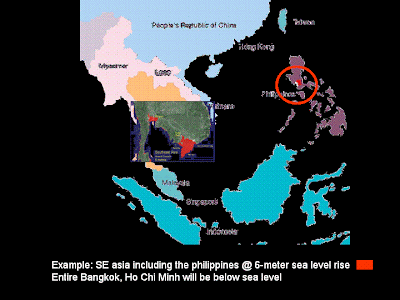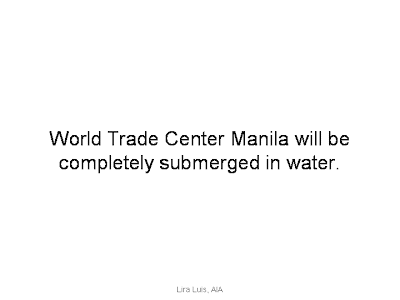Is the Philippines then, given its current economic condition accountable for the earth's global warming? In the past months, it experienced the extreme effects of climate change by way of flooding caused by typhoon Ketsana and Parma.
In 2007, I first presented a study I did about the potential for extreme flooding in the Philippines, based on information from Ed Mazria's Architecture 2030, during the United Architects of the Philippines 33rd National Convention. Now in 2009, it is as relevant today as it was 2 years ago when I delivered this keynote. I'd like to share an important point from that presentation. Here it goes:

This is the size of the Philippines in relation to the whole world:

It is almost the same size as the State of Arizona, USA.

If the size of the country is small compared to the rest of the world, then its carbon emissions couldn't impact that much as compared to other larger nations. Is this one of the reasons why the construction industry in the Philippines is plagued by irresponsible land development practices? The urge to imitate western cities was one of the planning solutions that would make the country look more developed than it actually is. Or its citizens are too busy praising and electing celebrities in important government positions and failing to make climate change a priority. Remaining vigilant about this issue has been stressed by fellow architect Felino "Jun" Palafox, Jr.


The Philippines is accountable because it shares the planet with the rest of the world.

Chris Leubkeman of Arup, during his presentation for Architecture 2030, pointed out that the increase in population over the course of the next decade will require a systems thinking of sustainable carbon-neutral urbanization for new cities being developed to maintain security.




This was a "projected" study I did about the possible effects of climate change specifically in the Philippines:


In Ed Mazria's presentation for Architecture 2030, he explained via a map how global warming and increase in sea levels would affect parts of Asia.

There was not much information about how climate change would affect the Philippines, however, I cared enough to take that information as point-of-departure and "speculate" this to happen to the Philippines, based on solid research. Bear in mind, I gave this presentation back in 2007. At that time, I had both skeptics and open-minds in the audience.

This was almost right-on-the-money during the recent floods in major cities of the Philippines.

In 2009 when Ketsana made landfall, Manila (where the World Trade Center--the venue of this keynote presentation during the 33rd UAP National Convention) was submerged in water, along with the cities of Marikina, Malabon, Muntinlupa, Quezon, Makati, the city of Manila, Pasay, Pasig, Antipolo, Taguig, Valenzuela and San Juan. Flooding also occured in nearby provinces of Bulacan, Rizal, Laguna and other Southern Tagalog areas.

ARE YOU PREPARED FOR THE PHILIPPINES YOU WILL INHERIT?
Something to think about as we approach a new year...
...
Want to Re-Post this Article?
We received numerous requests to repost this article. Please feel free to do so as long as you add this license together with the article's re-post:

What Are You Thinking For 2010? by Lira Luis, AIA, RIBA, NCARB, UAP, LEED AP is licensed under a Creative Commons Attribution-No Derivative Works 3.0 Philippines License.
Based on a work at liraluis.blogspot.com.









0 comments:
Post a Comment